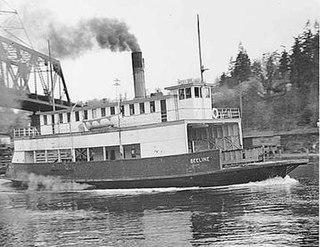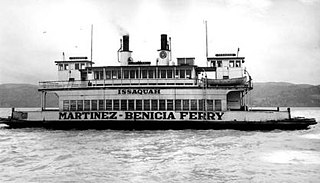
Lake Washington steamboats and ferries operated from about 1875 to 1951, transporting passengers, vehicles and freight across Lake Washington, a large lake to the east of Seattle, Washington. Before modern highways and bridges were built, the only means of crossing the lake, other than the traditional canoe or rowboat, was by steamboat, and, later, by ferry. While there was no easily navigable connection to Puget Sound, the Lake Washington Ship Canal now connects Lake Washington to Lake Union, and from there Puget Sound is reached by way of the Hiram M. Chittenden Locks.

The King and Winge Shipbuilding Company was an important maritime concern in the early 1900s on Puget Sound. The shipyard was located at West Seattle. The owners were Thomas J. King (1843–1925) and Albert M Winge. King was born in Boston and learned to build ships under the famous Donald McKay. He came to Puget Sound in about 1880, and worked in the shipyards of Hall Bros. and T.W. Lake before starting his own shipyard with Winge. King’s partner, Albert L. Winge was a native of Norway.

The steamboat Aquilo operated on Lake Washington and Puget Sound in the first part of the 20th century.

The steamboat Fortuna was a vessel that operated on Lake Washington in the first part of the 20th century.

The steamboat Rosalie operated from 1893 to 1918 as part of the Puget Sound Mosquito Fleet, also operating out of Victoria, B.C. In 1898, Rosalie went north with many other Puget Sound steamboats to join the Klondike Gold Rush.

Colman Dock, also called Pier 52, is the primary ferry terminal in Seattle, Washington, United States. The original pier is no longer in existence, but the terminal, now used by the Washington State Ferry system, is still called "Colman Dock".

Hyak was a wooden-hulled steamship that operated on Puget Sound from 1909 to 1941. This vessel should not be confused with the sternwheeler Hyak which ran on the extreme upper reach of the Columbia River at about the same time. The name means "swift" or "fast" in the Chinook Jargon.
The Kitsap County Transportation Company was an important steamboat and ferry company that operated on Puget Sound. The company was founded in 1898 as the Hansen Transportation Company.

Lady of the Lake was a wooden steamboat that operated on Puget Sound from 1897 to 1903. Following a fire in 1903, the vessel was rebuilt as the tug Ruth.

Florence K was a steamboat that was operated on Puget Sound from 1903. This vessel was later renamed Gloria and was rebuilt as a steam ferry and renamed Beeline.

General Miles was a steamship constructed in 1882 which served in various coastal areas of the states of Oregon and Washington, as well as British Columbia and the territory of Alaska. It was apparently named after US General Nelson A. Miles.

The City of Seattle was a side-wheel driven steam-powered ferry built in 1888. This vessel was the first ferry to operate on Puget Sound. City of Seattle was also used in the San Francisco Bay area starting in 1913. The ferry was known as YFB54 when owned by the U.S. navy in World War II, and as Magdalena during naval service and for a time following the war. The upper works of the ferry have been mounted on a barge hull, and are now in use as a houseboat in Sausalito, California.

West Seattle was a side-wheel driven steam-powered ferry built in 1907.

Issaquah was a steam ferry built in 1914 that operated on Lake Washington and in San Francisco Bay.

King County was a steam ferry built in 1900 which served on Lake Washington until 1908.

The Seattle–Bainbridge ferry is a ferry route across Puget Sound between Seattle and Bainbridge Island, Washington. The route was called the Seattle–Winslow ferry before the city of Winslow annexed the rest of the island and changed its name. Since 1951 the only ferries employed on the route have belonged to the Washington state ferry system, currently the largest ferry system in the United States.

The Grand Trunk Pacific dock was a shipping pier in Seattle, Washington. The original pier was built in 1910 and was destroyed in a fire in 1914. The pier was then rebuilt and continued in existence until 1964, when it was dismantled. The area where the pier stood is now part of the Seattle terminal of the Washington State Ferry system.

Atlanta was a steamboat built in 1908 at Houghton, Washington which served on Lake Washington and Puget Sound until 1938, when it was converted into a diesel-powered houseboat.

Speeder was a motor launch built in 1908 which served on Puget Sound and in the San Juan Islands. From 1908 to 1922 this vessel was named Bainbridge.

Falcon was a 26 registered ton gasoline-powered launch built in Bellingham, Washington in 1909. She operated in Puget Sound and nearby regions, and also on Lake Washington during the first part of the 1900s. The wreck of this vessel has been discovered in Lake Washington not far from Kirkland and is in good condition under 190 feet (58 m) of water. This vessel should not be confused with the steam tug Falcon built in Tacoma, Washington in 1902.




















